
Salvia brevilabra is a perennial plant that is native to Sichuan province in China, growing on hillsides, grasslands, and in forests at 3,200 to 3,800 m elevation. It grows up to 60 cm (24 in) tall, with basal leaves that are ovate to triangular-ovate, 9 to 11 cm long and 5 to 7 cm wide. The stem leaves are somewhat smaller, and more triangular in shape.
Salvia himmelbaurii is a perennial plant that is found growing on grassy slopes at 3,300 m (10,800 ft) elevation in Sichuan province in China. It grows 30 to 45 cm tall, with cordate-ovate leaves that are 5 to 10 cm long and 3.5 to 7.5 cm wide. The upper leaf surface is covered with soft hairs, with the underside having hairs especially on the veins.
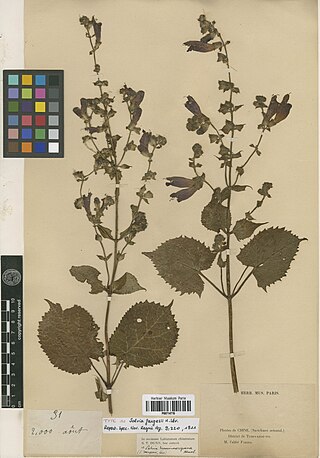
Salvia maximowicziana is a perennial plant that is found growing on grasslands, forests, and forest edges in China, at 1,800 to 3,300 m elevation. It grows 10 to 90 cm tall, with circular-cordate to ovate-cordate leaves that are typically 3 to 8 cm long and 6 to 8 cm wide. The upper leaf surface is nearly smooth, or lightly covered with hairs, while the underside has glandular hairs on the veins.
Salvia paohsingensis is a perennial plant that is native to Sichuan province in China, growing in forests at 2,800 m (9,200 ft) elevation. It is related to Salvia maximowicziana. S. paohsingensis grows on slender, ascending to suberect stems, from 20 to 40 cm tall.

Salvia cyclostegia is a perennial plant that is native to forests, grasslands, and hillsides in Sichuan and Yunnan provinces in China, growing at elevations from 2,700 to 3,300 m. The leaves are broadly ovate to circular, and range in size from 2.3 to 13 cm long and 1.2 to 6.5 cm wide.

Salvia omeiana is a perennial plant that is native to forest edges and hillsides in Sichuan province in China, growing at 1,400 to 3,100 m elevation. It is a robust erect-growing plant reaching .4 to 1 m, with broad cordate-ovate to hastate-ovate leaves that are 10 to 16 cm long and 6.5 to 14.5 cm wide. Inflorescences are raceme-panicles, with a 2.5 to 3.5 cm yellow corolla.
Salvia alatipetiolata is a perennial plant that is native to Sichuan province in China, growing on grassy hillsides at 3,800 m (12,500 ft) elevation. The plant grows on erect stems up to 40 cm (16 in) tall, with numerous basal leaves that are ovate-hastate, ranging in size from 3.5 to 6 cm long and 1.5 to 4.5 cm wide. The upper leaf surface is mostly smooth, while the underside has many gray hairs.
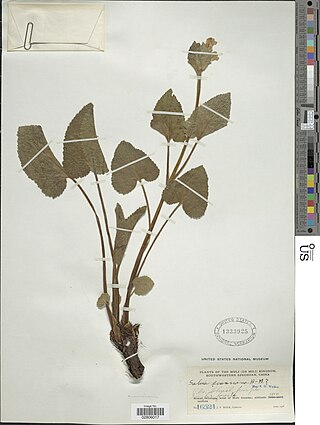
Salvia evansiana is a perennial plant that is native to Sichuan and Yunnan provinces in China, found growing on alpine meadows, hillsides, and forests at elevations from 3,400 to 4,300 m. It has erect stems growing 13 to 45 cm tall, with ovate to triangular-ovate leaves that are 2 to 11 cm long and 1 to 11 cm wide.
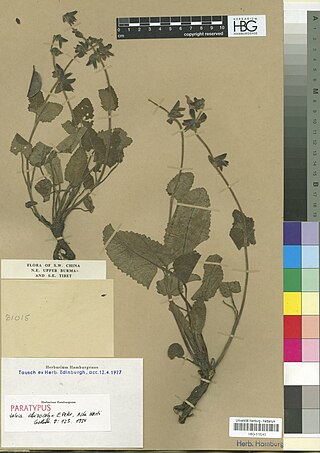
Salvia schizocalyx is a perennial plant that is native to Yunnan province in China, growing at 4,000 m (13,000 ft) elevation. The plant grows on one to a few unbranched upright stems with widely spaced leaves, reaching approximately 45 cm (18 in) tall. The leaves are broadly ovate to narrowly triangular-ovate, and rarely oblong-ovate, typically ranging in size from 2 to 5 cm long and 1.2 to 4.5 cm wide, though they can grow larger.
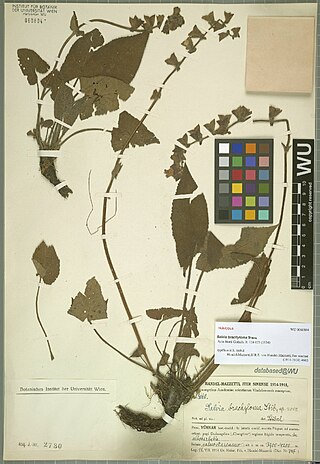
Salvia brachyloma is a perennial plant that is native to Yunnan and Sichuan provinces in China, growing on grassy slopes and forested grasslands at 3,200 to 3,800 m elevation. The plant grows on one to a few stems from 20 to 57 cm tall. The leaves are hastate to narrowly ovate, ranging in size from 3.5 to 11 cm long and 2 to 5 cm wide.

Salvia mairei is a perennial plant that is native to Yunnan province in China. The plant grows on one to a few stems from 20 to 40 cm tall. The leaves are cordate-ovate to subhastate-ovate, typically ranging in size from 3.5 to 5 cm long and 1.8 to 5 cm wide, though they are sometimes larger. Inflorescences are 4-flowered verticillasters on terminal racemes or panicles that are 8 to 11 cm long. The corolla is violet or purple, 1.5 to 1.8 cm long.

Salvia schizochila is a perennial plant that is native to the Yunnan province in China, found growing in forests at 3,800 to 4,300 m elevation. S. schizochila grows on erect, unbranched stems to 20 to 25 cm tall. The leaves are broadly cordate-ovate, ranging in size from 4 to 9 cm long and 4 to 9 cm wide. Inflorescences are of dense racemes, with a purplish corolla that is 1.8 to 2.2 cm.
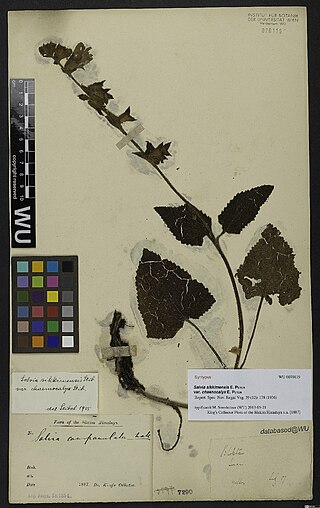
Salvia sikkimensis is a perennial plant that is native to Xizang province in China, along with locations in Bhutan and India (Sikkim). It is typically found growing in and around forests, on hillsides, and streamsides at 3,300 m (10,800 ft) elevation.
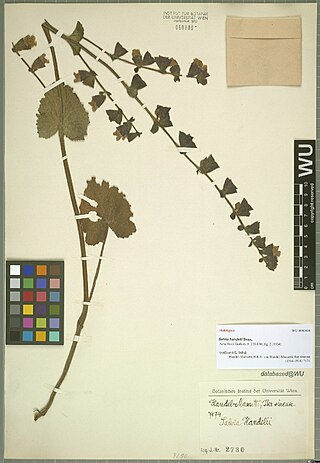
Salvia handelii is a perennial plant that is native to Sichuan province in China, growing on grassy slopes on limestone mountains at 3,800 to 3,900 m elevation. S. handelii grows on one or two ascending stems to 50 to 80 cm tall. The leaves are broadly ovate-triangular to subcircular, ranging in size from 8 to 19 cm long and 4 to 19 cm wide. Inflorescences are in terminal racemes or raceme-panicles up to 25 cm (9.8 in), with a green-white corolla with violet spots that is 1.8 to 2.2 cm.
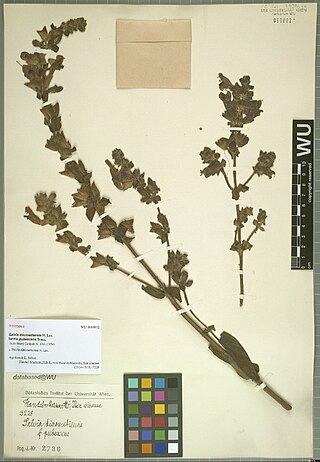
Salvia kiaometiensis is a perennial plant that is native to Sichuan and Yunnan provinces in China, found growing on hillside grasslands at 2,300 to 3,200 m elevation. S. kiaometiensis grows 25 to 50 cm tall, with ovate leaves that are 4 to 15 cm long and 2 to 10 cm.
Salvia subpalmatinervis is a perennial plant that is native to Yunnan province in China, found growing in thickets, forests, and hilly grasslands at 3,400 to 4,000 m elevation. S. subpalmatinervis grows on one to three erect stems to 50 cm (20 in) tall, with mostly basal leaves that are ovate to circular.

Salvia mekongensis is a perennial plant native to Yunnan province in China, found growing on hilly grasslands at 2,800 to 4,100 m elevation. S. mekongensis grows on one to five ascending to erect stems, with mostly basal leaves that are usually ovate to oblong-ovate, 3 to 9 cm long and 2 to 8 cm wide.
Salvia sinica is a perennial plant that is native to the hills of Anhui and Zhejiang provinces in China. S. sinica grows on one to a few erect stems to 50 to 100 cm tall, with stem leaves that are narrowly ovate and smaller terminal leaflets that are ovate to oblong-lanceolate. Inflorescences are 5–12 flowered verticillasters in terminal racemes, with a corolla that is tawny, purplish or purple on the upper lip, 1.6 to 2.2 cm.
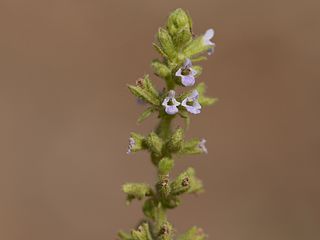
Salvia plebeia is an annual or biennial herb that is native to a wide region of Asia. It grows on hillsides, streamsides, and wet fields from sea level to 2,800 m (9,200 ft). S. plebeia grows on erect stems to a height of 15 to 90 cm tall, with elliptic-ovate to elliptic-lanceolate leaves. Inflorescences are 6-flowered verticillasters in racemes or panicles, with a distinctly small corolla that comes in a wide variety of colors: reddish, purplish, purple, blue-purple, to blue, and rarely white.
Salvia anatolica is a rare perennial herb that is endemic to a small area between Divriği and Kemaliye in Turkey, growing on stony slopes and oak scrub forest at 1,500 to 1,650 m elevation. It is similar to another Salvia that is endemic to Turkey, S. bracteata.













